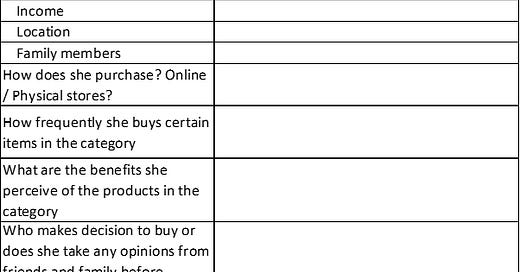#Post 5 - How to develop shopper profiles for your category
In this post, we will talk about shoppers profile as well as STP framework. Step-1 : Category planning, strategy
In the previous post, we have understood how consumers make decisions to buy items in a particular category. This also helped us to understand that there are many kinds of shoppers. Shoppers who value time, value for money shoppers, or shoppers who hunt discount etc. etc.
As a category manager, you need to understand different shopper’s profile so that you can serve the needs of a particular shopper better. You will also be using shopper’s profile to design your communication strategy targeted towards a particular shopper’s profile or persona.
The sample data from shoppers can be collected in this form of questionnaire :
Once you have collected a reasonable no. of shopper’s data, you will have an understanding of who your shoppers are? why do they buy? what do they buy? etc. etc.
This is the first step towards STP : Segmentation, Targeting, and positioning.
Peter Drucker once said, “The customer rarely buys what the business thinks it sells him.” The problem is we don’t know what kinds of jobs customers are going to need done unless we follow each customer’s journey.
Shopper’s profile data would help you to understand traits, and attributes of a particular group of profiles. Once you do that, you can identify if you need to target all or few based on your organizational / category goals / resources.
One of the HBR article recommends to segment based on a particular job / need that a product does for customers.
https://hbr.org/2013/06/a-new-framework-for-customer-s
Let’s apply the framework. On furniture category - Sofa.
Here is how the “job done” segmentation will work :
Step #1: Identify the contexts in which customers are using the company’s products.
Being relaxed and lazy
Watching Television
Lie down and reading books on Kindle
Entertaining guests
Step #2: Combine information about transactions and customer behavior in the contexts to describe each of the jobs to be done.
We can get quantitative data on which activity is important for what kind of users.
Step #3: Map individual customers to jobs, using the data.
Let’s say 40% of users who fall under high income use it mostly for entertaining guest.
Now we can ask what kind of sofa they would like to buy. They might buy sofa that goes with the theme of their house, that matches with their interior design - overall Look is important. Could we get the best of the world for the customers - comfort and design. As a category owner, could you provide the customers personalized product?
So you see, once you know who your target segments needs are, in what context they use the product, you can develop your category better. You can have a better assortment that would meet your category goals.




